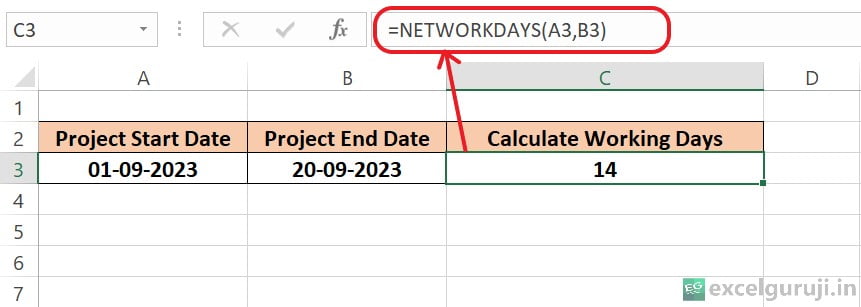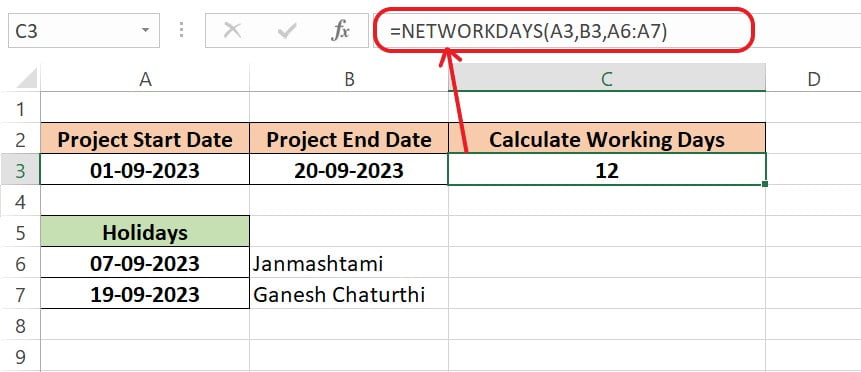Contents
Excel NETWORKDAYS Function

When to Use the Excel NETWORKDAYS Function in Excel
Excel NETWORKDAYS function is a valuable tool when you need to calculate the number of working days between two dates. It is particularly useful in scenarios where you want to determine deadlines, project durations, or simply track the number of business days between two events.
What Excel NETWORKDAYS Function Returns
The Excel NETWORKDAYS function returns the count of working days (weekdays) between two specified dates. It excludes weekends and allows for the consideration of custom holidays, making it a versatile function for various business and project management tasks.
Syntax of Excel NETWORKDAYS Function
The syntax of the Excel NETWORKDAYS function is as follows:
=NETWORKDAYS(start_date, end_date, [holidays])
Input Arguments
Here are the input arguments for the Excel NETWORKDAYS function:
● start_date: This is the beginning date from which you want to start counting working days. It can be a reference to a cell containing a date, a direct date entry enclosed in quotation marks, or a formula that evaluates to a date.
● end_date: This is the end date up to which you want to count working days. Similar to start_date, it can be a cell reference, a direct date entry, or a formula result.
● holidays (optional): This argument allows you to specify a range of cells containing holiday dates to be excluded from the calculation. Holidays are optional, and you can omit this argument if you don’t need to consider holidays.
Extra Notes
● The NETWORKDAYS function considers Monday through Friday as working days and excludes weekends (Saturday and Sunday) by default.
● If you provide a range of holiday dates in the holidays argument, these dates will also be excluded from the count.
● When any of the arguments isn’t a valid date, NETWORKDAYS will result in an #VALUE! error.
Examples of the Excel NETWORKDAYS Function
Here are a few examples of how to use the TODAY function:
Example 1: Basic Usage
Suppose you have a project that starts on September 1, 2023 (cell A3) and ends on September 20, 2023 (cell B3). To calculate the number of working days for this project, you can use the following formula:

This formula will return the result of 14, as there are 14 working days between these two dates, excluding weekends (Saturday, Sunday).
Example 2: Including Holidays
In a project that spans multiple weeks, you may want to account for holidays. Suppose you have a list of holidays in cells A6 to A7. You can modify the formula as follows:

Now, the function will also exclude the holidays specified in the range A6:A7 from the calculation.
Example 3: Nested Functions with IF and TODAY()
You want to display a message based on the number of working days remaining until a project deadline. If the deadline is more than the working days away, display Plenty of time, otherwise, display Hurry up!

=IF(NETWORKDAYS(A3, TODAY()) < B3, “Plenty of time”, “Hurry up!”): This formula calculates the number of working days between the project start date (A3) and the current date (TODAY()) using the NETWORKDAYS function. Then, it compares this calculated value to the number of working days required to complete the project (B3).
- If the calculated number of working days is less than the days required to complete the project, it means there is Plenty of time.
- If the calculated number of working days is equal to or greater than the days required to complete the project, it means you need to Hurry up!.
Conclusion
In summary, the Excel NETWORKDAYS function is an essential tool for anyone working with date-related calculations in a business context.
It simplifies the process of counting working days and allows for the exclusion of weekends and holidays, making it ideal for project management, scheduling, and deadline tracking.
As you become more proficient in Excel, you will find that mastering functions like NETWORKDAYS can significantly improve your productivity and accuracy in handling date-related tasks. So, start using NETWORKDAYS today, and unlock its potential for your Excel projects!
Frequently Asked Questions (FAQs)
Q1: Can the NETWORKDAYS function be used to calculate the number of days, including weekends?
A1: No, the NETWORKDAYS function is specifically designed to calculate the number of working days, excluding weekends.
Q2: Can I use NETWORKDAYS to calculate working days for irregular workweeks (e.g., Monday, Wednesday, Friday only)?
A2: No, The NETWORKDAYS function in Excel does not directly support irregular workweeks; it is designed for standard Monday-through-Friday workweeks. Additionally, it may exclude holidays in calculation. If you want to calculate working days for irregular workweeks you can use NETWORKDAYS.INTL function
Q3: Is it possible to use NETWORKDAYS to calculate partial days (e.g., half a working day)?
A3: No, NETWORKDAYS counts whole working days. If you need to calculate partial days, you may need to use a different approach or formula.
Other Related Excel Functions
Join me on Instagram, YouTube and WhatApp Channel for your daily dose of valuable tips and tricks! Catch insightful videos that will enhance your knowledge and skills. Don’t miss out – follow me now!